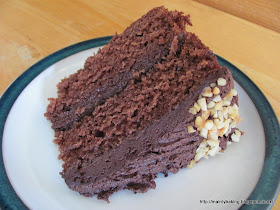This month's challenge to use honey is a case in point. I tried to think of recipes where the flavour of the honey would be prominent, as that is surely the aim of the challenge - there's no point using an ingredient if you can't taste it in the finished article. There was the added problem that baking with large amounts of honey can be problematic too, as I found with a batch of biscuits that ended up like a lace curtain across the baking tray. The pieces tasted great, when I eventually got them to harden and set, but it was impossible to half-coat them in chocolate, which had been my intention.
Eventually, using leftovers from Easter, I decided to make a cheesecake, using chocolate coated oat biscuits for the base, and adding a chocolate sour cream layer on top. Unfortunately, although each component worked well on it's own (apart from a slightly soggy base!), the honey cheesecake mixture just didn't taste right with the two chocolate layers. It may just have been the particular honey I used - my current favourite is a Romanian Lime Blossom honey which has a distinctive citrus flavour, and I'm always wary of pairing citrus, other than orange, with chocolate.
I couldn't find a recipe for a cheesecake mixture which was exactly what I wanted, but in the end I used this recipe from Canadian Living as the basic inspiration. I had to reduce the quantities a little to accomodate the fact that I only had 400g cream cheese, and I cut back the honey even more - to 100g - as I didn't want it to be too sweet.
Ingredients
 180g chocolate coated biscuits - I used IKEA Kakor Chocladflard (double chocolate crisps) but would have used chocolate coated hobnobs if these weren't sitting in my storecupboard approaching the use-by date!
180g chocolate coated biscuits - I used IKEA Kakor Chocladflard (double chocolate crisps) but would have used chocolate coated hobnobs if these weren't sitting in my storecupboard approaching the use-by date!90g melted butter
400g full fat cream cheese
100g Lime Blossom honey
2 medium eggs
60g sour cream
rind and zest of 1 small lemon
140ml tub sour cream
2 tablespoons caster sugar
25g finely grated 100% cacao block
Method
Use a 7" springform tin and cover the outside with several layers of aluminium foil, so that it can go into a bain-marie. Heat oven to 180C.
Crush the biscuits to fine crumbs, stir in the butter and use to make an even, compressed base in the springform tin. Bake for 10 minutes, then cool.
Beat the cream cheese with the honey, until smooth, then mix in the eggs, lemon and the 60g quantity of sour cream until well combined. Pour onto the crumb base and bake in a bain-marie for 45 minutes or until set but still wobbly. Remove from oven, but leave in bain-marie.
Combine the tub of sour cream with the sugar and grated cacao, spread over the cheesecake and return to the oven for 15 minutes. Turn off the heat, open the oven door slightly and leave the cheesecake for 30 minutes. Remove from oven, and run a knife between the cheesecake and the sides of the tin (may help prevent cracking).
When the cheesecake is cooled to room temperature, refrigerate for at least 6 hours before serving. Don't cover the cheesecake until it is fully chilled as you may get condensation on the surface!
As I said earlier, apart from a soggy bottom in the centre of the cheesecake, each of the three parts were very good. The base was well flavoured with chocolate and oats, the cheesecake mixture was smooth with a hint of citrus alongside the honey flavour, and the set sour cream topping with added chocolate was delicious. They just didn't work together.
So, not a great success, but I was really pleased with the chocolate sour cream topping, which I'm sure to use again.
 We Should Cocoa is a baking challenge started by Chele from Chocolate Teapot, and Choclette from Chocolate Log Blog. Each month a different ingredient is chosen to be paired with some form of chocolate in our cooking. This month's choice of honey was made by Choclette, who will be posting a round-up at the end of the month.
We Should Cocoa is a baking challenge started by Chele from Chocolate Teapot, and Choclette from Chocolate Log Blog. Each month a different ingredient is chosen to be paired with some form of chocolate in our cooking. This month's choice of honey was made by Choclette, who will be posting a round-up at the end of the month.













